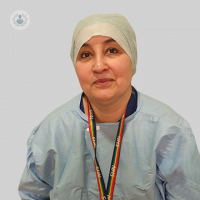Breast reduction: An expert answer your questions
Autore:Miss Salma Naseem is a leading oncoplastic, reconstructive and aesthetic breast surgeon. In her latest article, Miss Naseem answers the most frequently answered questions about breast reduction.

What is breast reduction and what are the common reasons for performing a breast reduction?
Breast reduction involves reducing the size of the breasts to make them appear smaller with an improved appearance. This is achieved by removing excess fat and skin from the breasts, and re-shape to make them look better and uplifted.
It is a life-changing operation that has immense physical and mental benefits.
There are many reasons to undergo a reduction procedure. Some women have had large breasts since puberty, a condition called gigantomastia or the breasts may be large and asymmetrical in shape and size developmentally. The other common causes that result in large breasts include weight gain during pregnancy, breastfeeding, or a general increase in body weight.
It affects self-confidence, and self-esteem impacting relationships, affecting the choice of clothing and social life. These factors have a detrimental effect psychologically and may affect mental health.
The large size of breasts may result in constant neckache, backache, shoulder grooving, change in posture, and recurring infections underneath along the breast crease.
What are the techniques for breast reduction?
Breast reduction surgery is different for every person depending on the size and shape of the breast. The most appropriate technique is discussed at the consultation when various breast measurements and the position of the new nipple are noted.
It is very important that the patient's understanding of the new 'cup size' is discussed and advised accordingly. Cup size cannot be guaranteed. Pr- and post-reduction photos of patients are shown to enhance understanding.
The position of the new nipple and skin markings customised for the individual patient is done on the day of surgery. The various techniques involve a scar around the areola and vertically. In breasts requiring excess skin removal anchor shape or inverted T scar is planned. In gigantomastia, or excessively large breasts free nipple graft technique may be used. This involves the removal of the nipple-areolar complex and siting it in the new position of the reshaped breast as a skin graft.
What are the potential risks and complications of breast reduction?
Breast Reduction is undertaken under general anaesthesia as a day case, there is however provision of an overnight stay. Drains are placed in either breast and generally removed next day. The possible complications include
- bleeding
- hematoma

- bruising
- infection (higher rate in smokers)
- chronic pain
- excessive scarring (keloid, hypertrophic)
- asymmetry in nipple position
- breast size, delayed wound healing,
- skin and wound breakdown
- dog ears, reduced sensation of the nipple
- temporary or permanent loss of sensation
- partial or complete nipple loss
- nipple reconstruction,
- inability to breastfeed
- feeling lumpy areas (traumatic fat necrosis)
- clots in leg and lungs
- revisional surgery
- bottoming out and failure to achieve intended results
What are the instructions following surgery and what is the recovery period?
Following the procedure, a support bra is to be worn for 3 to 4 weeks.
You must also avoid driving and lifting for 4 weeks. Light duties and desk jobs can be resumed after 10 days. Heavy duties are to be resumed after 6 weeks.
Everyone heals differently following this surgery, and the final results may take up to a few months to show.
Follow-up is planned as 2 weeks, 6 weeks, and 3 months following surgery.
Is Breast reduction surgery for me?
Breast reduction is a life-changing operation. Feedback from the patients indicates that it not only improves their physical health but that their mental well-being and self-confidence are hugely improved.
Miss Salma Naseem is a leading oncoplastic, reconstructive and aesthetic breast surgeon. If you would like to book a consultation with Miss Naseem you can do so today via her Top Doctors profile.


